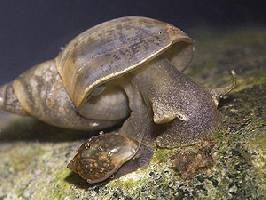
Description de l'animal
The Great Pond Snail, scientifically known as Lymnaea stagnalis, is a fascinating creature that belongs to the family Lymnaeidae. This species of freshwater snail is one of the largest pond snails in its habitat, with adult shells reaching up to 60 mm in length and about 20 mm in width, although sizes can vary. The shell of Lymnaea stagnalis is characteristically elongated and spiraled, with a pointed apex and a relatively thin, translucent structure. Its coloration ranges from light brown to greenish, often reflecting the environments in which the snails reside.Lymnaea stagnalis is widely distributed across Europe, extending its range into parts of Asia and even Northern Africa. Its preferred habitats are still or slow-moving freshwater bodies such as ponds, lakes, and slow rivers where there is an abundance of vegetation. This vegetation not only provides the snails with a source of food but also with shelter and breeding grounds.
The diet of the Great Pond Snail is quite varied, including a wide range of organic matter. They are known to feed on algae, detritus, and plant material, both living and decaying. This diet makes them an integral part of the aquatic ecosystem, contributing to the decomposition process and nutrient cycling within their habitats.
One of the most interesting aspects of Lymnaea stagnalis is its reproductive behavior. They are hermaphroditic, meaning each individual possesses both male and female reproductive organs. Despite this, they typically require a partner to reproduce. Mating involves a complex courtship ritual, after which eggs are laid in gelatinous masses on aquatic vegetation. These egg masses can contain up to 50 eggs, from which tiny snails emerge, already possessing a small shell.
The life cycle of the Great Pond Snail is subject to the conditions of their environment, particularly temperature, which influences their growth rate and reproductive cycle. In ideal conditions, they can live up to three years, although this can vary significantly.
Lymnaea stagnalis plays a crucial role in their ecosystems, not only in nutrient cycling but also as a food source for various predators, including fish, birds, and insects. However, they can also act as intermediate hosts for certain parasites, which can affect both wildlife and livestock.
In recent years, Lymnaea stagnalis has garnered interest from the scientific community for its use in studies related to neurobiology and environmental monitoring. Their relatively simple nervous system makes them excellent models for neurological research, while their sensitivity to pollutants allows them to serve as bioindicators for water quality assessment.
Despite their ecological importance and the interest they hold for science, Great Pond Snails face threats from habitat loss, pollution, and the introduction of invasive species. Conservation efforts are crucial to ensure that these intriguing creatures, and the ecosystems they support, continue to thrive for generations to come.
Animaux similaires
Nouvelles photos d'animaux
Top 10 des animaux
- Dolphin gull (Leucophaeus scoresbii)
- Diana monkey (Cercopithecus diana)
- Moustached guenon (Cercopithecus cephus)
- Galápagos tortoise (Geochelone nigra complex)
- Russian tortoise (Testudo horsfieldii)
- Japanese macaque (Macaca fuscata)
- Stone loach (Barbatula barbatula)
- Greek tortoise (Testudo graeca)
- Common flying dragon (Draco volans)
- Vendace (Coregonus albula)
